
GuanaData, a project of The Voice of Guanacaste, investigates the public budgets of six municipalities in the country, including Talamanca. What are you going to read about in this investigative report?
- $455,000 for bridge construction for the canton goes unused.
- Municipality of Puntarenas has carried over $250,000 for building Fertica bridge for five years.
- Communities are still waiting for bridges, even though the municipality has had the money to build 15 of them for 7 years on average.
***
Fray Casiano is the largest community in the district of Chacarita. Here, 3,000 people live next to an estuary on land where a mangrove forest was cut down more than 40 years ago.
Every morning fishermen, teachers and vendors have to cross one of two pedestrian bridges that connect the neighborhood with the rest of Puntarenas.
Unless you have a car, the Fertica pedestrian bridges, as they are known in the community, are the shortest and most effective way out of Fray Casiano. From the bridges, 25 meters high (82 feet), you can see the magnitude of the estuary and the fishing boats that float calmly. If you look down, the scene is a bit scarier.
Between the huge gaps in the decaying bridge, you can see the estuary and the fishing boats below. The weak structures shake. The railings are made of frail wires. Parts of the floor are missing. Nobody in town recommends going on one of the bridges together with someone else.
These two bridges, which are almost 58 meters (190 feet) long, are among the 15 infrastructure projects that the Municipality of Puntarenas and the canton’s administration have failed to carry out between 2011 and 2019. All together, these projects total ₡273 million (about $455,000) that hasn’t been spent.
On average, the canton’s communities have waited almost seven years for the municipality to make the bridges a reality. However, to date, the local government still hasn’t used the budgeted funds.
Most of these unspent funds are designated for the areas farthest from the center, such as Cobano and Paquera, as well as areas of socioeconomic vulnerability such as Fray Casiano, a 20-minute drive from the center of the canton, where residents are forced to risk their lives and those of their children every day.
“Going over either of the two bridges is very dangerous. They are in very bad condition because the material has been damaged by the estuary’s water. All the same, we have to use them, because they are the only way to cross from Fray Casiano to the 20 de Noviembre neighborhood, and from there to Puntarenas,””, Elena Espinoza Mora, who lives in Fray Casiano and works with the Red Cross, told GuanaData.
The Municipality of Puntarenas is well aware of what the 3,000 people who live in the community go through. Since 2015, ¢150 million (about $250,000) has been budgeted to fix the infrastructure, but the design presented in 2016 by the municipality’s Roadways Technical Unit lacked technical studies and therefore couldn’t be built.
“Currently, right on the side of both bridges, there are irregular settlements that have been there for years. The old administration left a design that was simply unfeasible… If that bridge had been built, we would have had to evict at least 20 families,” Gabriela Murillo, director of the municipality’s Roadways Management Technical Unit, explained during a telephone interview.ad.
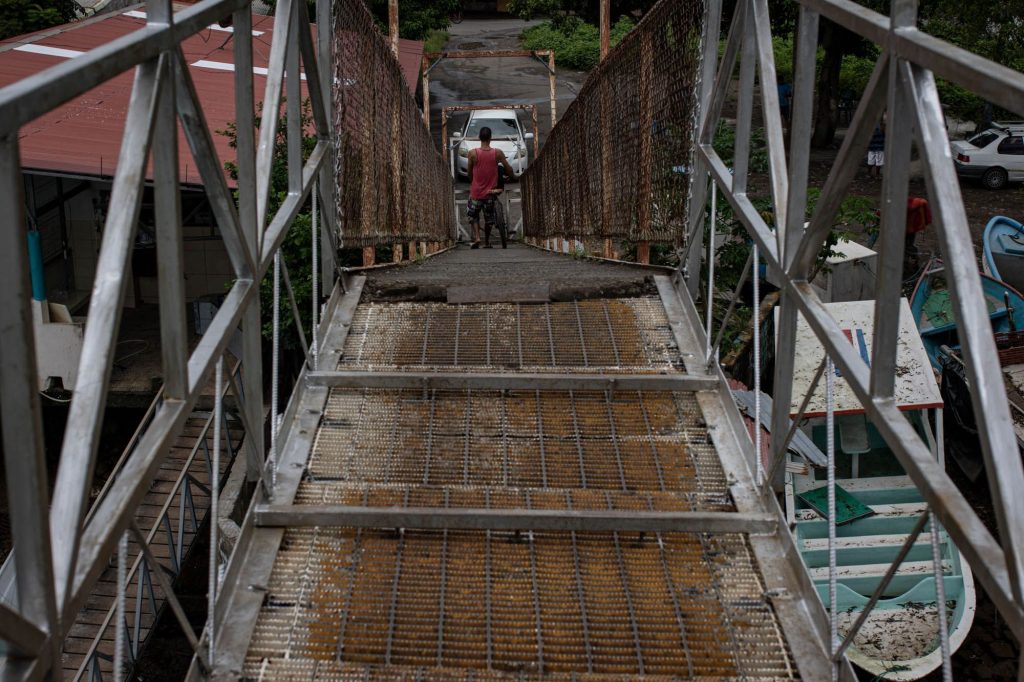
The municipality of Puntarenas has since 2015 ¢150 million for the construction of the Fertica Bridge. However, the bridges remain in poor condition. Photo: César Arroyo.
Another ₡128 million (about $215,000) is pending to be spent on infrastructure for communities far from central Puntarenas. For these projects, most of the responsibility lies with the administrations of the Cobano and Lepanto communities.
Due to the remoteness of these two communities from the center of Puntarenas, the administrations function as the local government figure responsible for implementing the funds, but it is the municipality of Puntarenas that receives this budget. Also, although the administrations have functional autonomy, the municipality could coordinate implementation of the projects and push them forward. So far, there have been no efforts.
The Fray Casiano Bridge: A Tale of Two Cities
The current municipality hasn’t built the Fray Casiano bridge because it considers the original plan from 2015 to be unfeasible indicating several problems with the design for the ¢150 million ($250,000) project: it didn’t take into account the water from the estuary nor how it could affect the bridge’s materials, nor the number of people who were going to use it or the lighting for evening use.Therefore, 5 years after formulating it, more resources are needed.
An additional cost of ¢35 million isn’t yet in the municipality’s budget, so the possibility of the bridge being built in 2020 is uncertain. On September 30, 2020, the Municipality of Puntarenas sent the Comptroller General of the Republic the 2021 budget proposal, in which they requested this money that would finally allow one of the bridges to be repaired.
Since the plan is budgeted for 2021, the government’s approval is still needed. Even if the municipality gets the green light to proceed, the public notice must be drafted and the construction work must be put out for bid and awarded. As time passes, people who live in the area keep waiting.
“We depend on the two bridges,” Elena stressed to GuanaData. “There is the possibility of traveling by bus, but due to the pandemic, the service was reduced to less than half. If I miss the bus, it means it could take me up to 40 minutes to get around to Santa Eduviges (another community in Chacarita).”
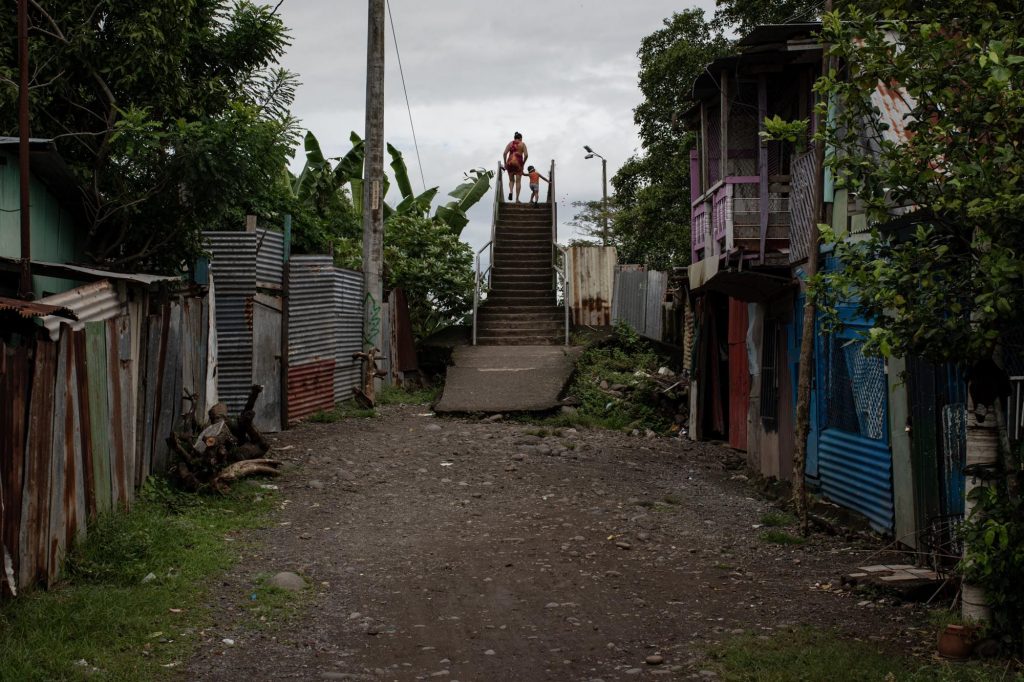
Apart from the poor condition, neither of the two bridges that connect the community enforce the 7600 law. Photo: César Arroyo.
The Fertica bridges have existed for more than 30 years, but people there don’t remember a time when the 58-meter-long (190-foot-long) giants were in good condition. They are built on 25-meter (82-foot) pilings that have been eaten away by salt, have fragile wire “railings” and a floor with parts missing.
The bridges don’t comply with the Equal Opportunities for People with Disabilities Law 7600 either because one has dozens of steps up and down both sides and the other has two steep ramps that even the bravest locals won’t go down on bicycle.
Children play, used to the concrete and metal structures that were originally built for workers at Fertica, a private company that exported fertilizers. Years later, the community multiplied, the company was nationalized by the state and the bridges became the responsibility of the municipality, which never renovated them.
The bridge is vital to the communities that it connects. The school and the Center for Education and Nutrition (Cen-Cinai) are on the 20 de Noviembre side. The Cen-Cinai functions as a care network, but during the pandemic, it became a distribution center for food for infants and children. One of the National Institute of Learning’s seven Professional Training Centers in Puntarenas, which the population of Chacarita can attend, is on the other side, in Fray Casiano.
Kevin Morales is one of the members of the Chacarita community who has had to cross this bridge over and over again.
“Without the INA in Fray Casiano, I wouldn’t have been able to study. Maybe someone from somewhere else doesn’t understand it, but for me, crossing the bridges brought me closer to getting my degree. The problem is that you get on and everything moves. On top of that, since they aren’t lit up, people get robbed at night,” Morales declared.
The fact remains that until the municipality fixes them, the two giants represent danger.
Why Hasn’t the Municipality Fixed the Fray Casiano Bridge?
According to the Roadways Management Technical Unit for the Municipality/span>of Puntarenas, building the original design for the bridge would require evicting some families from the area.
This conflicts with law 9242, which has prevented evictions since November 7, 2016..
The department resumed working on the project in 2018, without having a new design yet, but according to the entity, approval from the Comptroller’s Office to use the ¢150 million did not arrive on time.
In March 2020, they once again resumed the project to repair the bridge and decided to carry out a preliminary design.
“We have our own design that was made internally by the municipality and evaluated with three construction companies here in Puntarenas. The idea is that you don’t have to infiltrate anyone’s house and [the structures would] be made of wood so that they last,” Murillo explained.
According to this department and the municipal Department of Urban Development and Control, approval of the extra ¢35 million is necessary to build the bridge. The municipality sent its ordinary budget to the Comptroller General of the Republic on September 30, 2020 to be approved, but it won’t receive a response until December.
“After that budget is approved, what follows is writing and publishing the public announcement. To publish it, it must be approved by several municipal departments. For our part, we have to make sure that it complies with Law 7600. If the selection of the company can be achieved quickly, that is when we could start,” said the director of urban development and control, Mauricio Gutierrez.
Due to the pandemic, Murillo told GuanaData that he preferred not to give exact dates for when the repairs could begin but commented that he hopes to have the company that will fix the bridge selected by June of 2021.
Nonetheless, the ¢185 million would only cover the repair of one of the two bridges. This still leaves the other half of Fray Casiano with a route full of holes that doesn’t have railings.
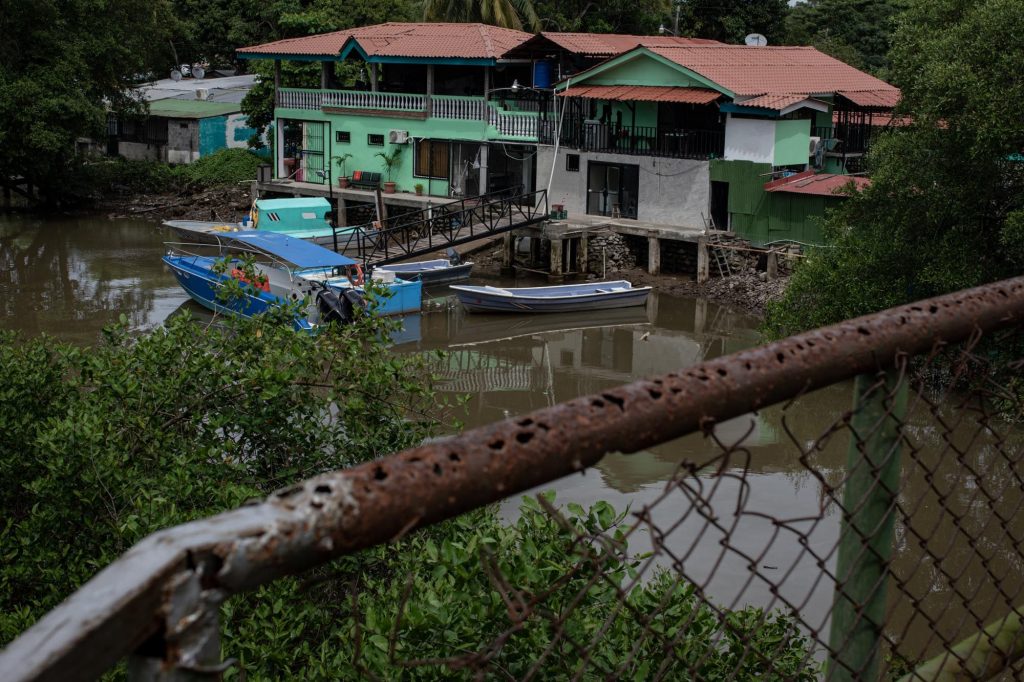
Between the huge gaps in the decaying bridge, you can see the estuary and the fishing boats below. Photo: César Arroyo.
Other Bridges Not Built
In the canton of Puntarenas, the community of Fray Casiano isn’t the only one needed to connect communities From 2011 to 2020, not counting the Fertica bridge, the municipality has carried over ¢128 million (about $215,000) that has been designated for bridges.
To date, 15 public works remain to be carried out. Most are pedestrian bridges in Cobano and Lepanto, located eight and seven hours by car respectively from downtown Puntarenas. Repairing the La Gloria bridge in Lepanto is one of them. The municipality has had ¢15 million ($25,000) in its budget unused since 2014.
Juan Carlos Lopez, who lives in Lepanto, can attest to this.
“Every year, the La Gloria bridge is flooded by the rains and the river, but what had happened to it is that one of the supports fell and was left slanted. The bridge is important because it connects two rural towns: Camaronal and La Gloria. There are about 200 of us who have to use that bridge every day to go to work and take the children to school,” he said during a telephone interview with GuanaData.
Lopez explained that lack of good infrastructure not only hinders access to work or study, but also puts the lives of the elderly who live in La Gloria at risk.
“From Camaronal up [towards La Gloria], it’s completely uphill and without that bridge, it’s not easy for ambulances to enter,” Lopez affirmed.
Because Cobano and Lepanto are far from the municipal office, they, along with six other towns in the country, have figures who perform the same work as the local government: the administrations. These have functional autonomy and the supervisor assumes the functions of mayor, but the municipality receives the budget. In these two cases, it’s the Municipality of Puntarenas.
Murillo, from the Roadways Management Unit for the Municipality of Puntarenas, told GuanaData that these bridges are the exclusive competency of those administrations, Código Municipal but the Municipal Code states that, since it is an affiliated body, the municipality could exert pressure and push those projects forward.
How Does a Bridge Change a Community?
The fact that the communities farthest from the center, or those that face greater socioeconomic inequality, lack good infrastructure is no coincidence, according to economist and researcher Marcela Roman.
““Without infrastructure, we are disconnected. The people with the least ability to pay end up living in the most complicated locations. Added to this, where we have large groups of the most vulnerable communities, the infrastructure is scarcer and more deteriorated. This is going to generate connectivity problems for me to get to where the opportunities are,” Roman told GuanaData.
In a province where less than 50% finish a secondary education, the possibility of crossing the bridge represents an opportunity, according to the most recentedition of the State of Costa Rican Education, from the State of the Nation Program..
Out of 81 cantons, Puntarenas ranked 31st in the most recentCantonal Human Development Atlas of Costa Rica. In addition, in the Social Development Index of the Ministry of National Planning and Economic Policy (Mideplan), Cobano, Lepanto and Chacarita obtained a score lower than 44.7, considered “very low development.”
This means that in Cobano (40.73), Chacarita (28.38) and Lepanto (18.93), access to health, education, work and infrastructure is extremely difficult.
“To me, the Fertica bridge represents studying, because I used to cross over there to get to the INA,” Kevin, who lives in 20 de noviembre, recalled. “And for my friends, it means going to the Paseo de los Turistas (Tourist Promenade) to work or to the Barranca area. It also means being able to cross to buy fish from the fishermen who live and work in the neighborhood.”
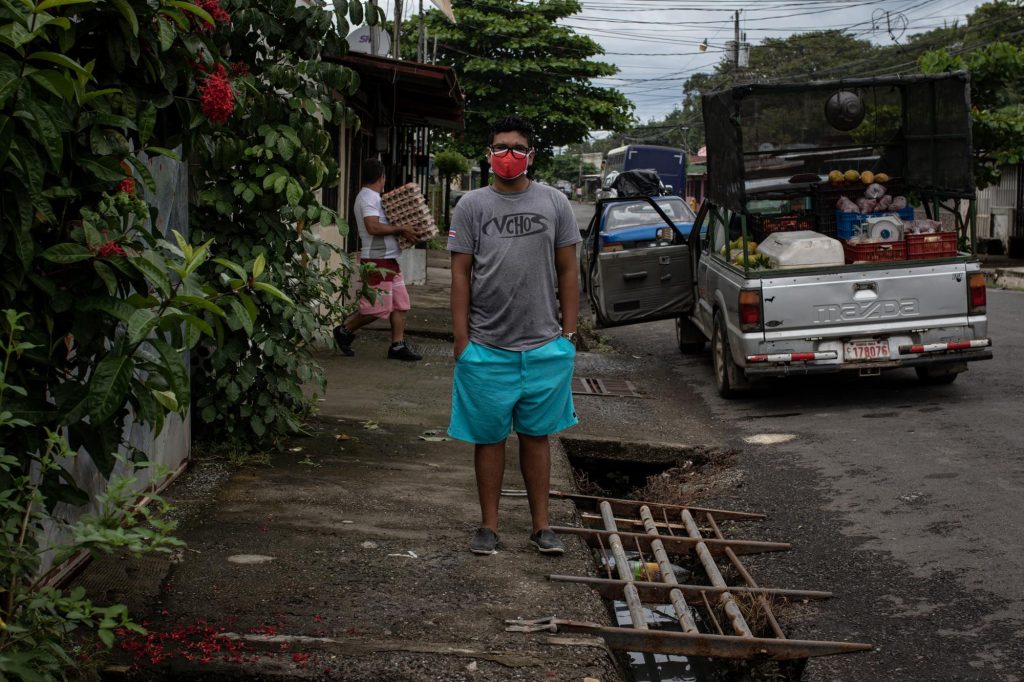
Kevin Morales, a neighbor of November 20, needs the bridges to study at the National Institute of Learning (INA). Photo: César Arroyo.
The municipality put a metal bar on the main bridge to prevent motorcycles from crossing and thereby slow the advanced deterioration of the bridges. However, this also complicates crossing on bicycles, the main means of transportation in Fray Casiano.
Alejandro Vallejo, an architect with Entre Nos Atelier, an organization that has designed the Child Care and Development Centers (CECUDI) in several cantons, recommends a solution beyond fixing the bridge: including the community in decision-making.
“When truly participatory consultation processes are opened in which the community itself explains what is needed, the positive impact is greater. Many times, lots of money is spent to build a bus stop, when what the community needed from the beginning is to fix the bridge.”
“If people need a bridge, and because it isn’t there, they have to take a bus, paying for that ticket every day can represent more than [they] manage to make in income.So the lack of that bridge represents less work or study opportunities. The lack of infrastructure breeds poverty,” concluded Roman.
********
This piece is part of the fourth edition of the GuanaData project, carried out by La Voz de Guanacaste with sponsorship of the International Center for Journalism, thanks to a grant from the United States Embassy. GuanaData intends to analyze the budgets of six local governments in the country in order to make the public function transparent and fight corruption within the municipalities.


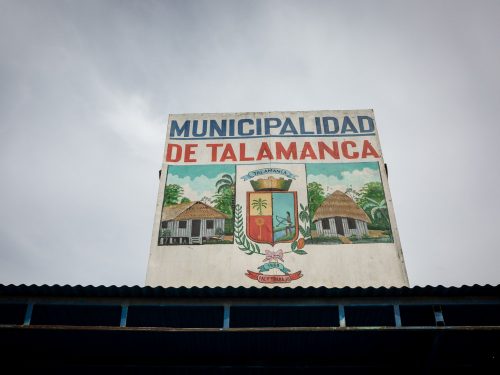
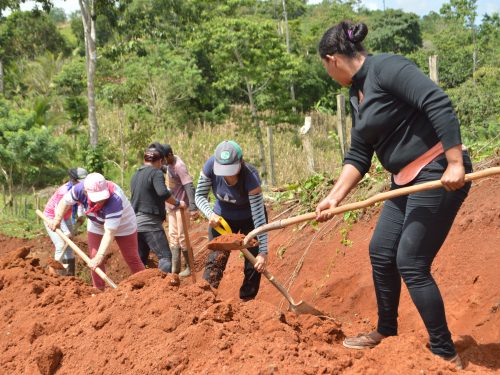


Comments